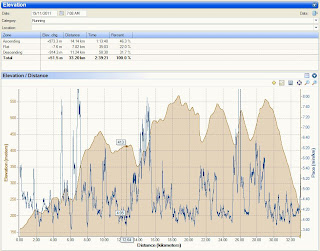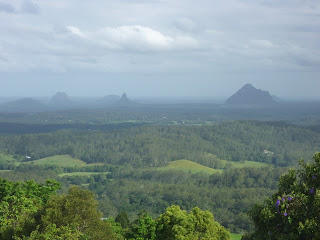It's been a while since I was last out running in the Dandenongs - back in March or April, I think - so it was great to get out there again today to put down the first few steps towards the 6ft Track marathon next March. I was after the hills, big hills, and these are some of the better ones in reasonable proximity to home. I have rule of training that you should never travel for more time to training than you are actually going to spend training...today ticked that box!!
I headed around a familiar old loop, plus a few extra bits, that takes in some of the best tracks in the area...just beautiful and spectacular forests and vegetation. The only problem today is that while it started very humid, the rain soon started and hung around although it didn't really make too much difference since the trees, ferns, tracks and more were already soaked - and muddy - with recent rains. So I got wet from the rain and general water and mud along the way. But I loved it.
Although my legs didn't feel great...which is perhaps more to do with being very out of shape for these hills / trails...I loved being up there. While wet, it wasn't cold, and hardly anyone else there. I'll be making routine tracks up there over summer...I want to achieve the goal of 40km+ and 2000m+ ascent in a single run. Today was 33km and 973m.
Here's a couple of pics of my muddy legs at the end.
Saturday, November 19, 2011
Thursday, November 17, 2011
Top 5 quick fixes
 The summer season is all but here and amongst the seasoned athletes are a whole lot of people who will be lining up for their first triathlon(s), with all the experiences that go along with...not to mention the newby mistakes!! So here are the top-5 quick fixes to correct the most common mistakes - and questions - new athletes make in their early races.
The summer season is all but here and amongst the seasoned athletes are a whole lot of people who will be lining up for their first triathlon(s), with all the experiences that go along with...not to mention the newby mistakes!! So here are the top-5 quick fixes to correct the most common mistakes - and questions - new athletes make in their early races.1. What to eat beforehand
In doing a sprint distance you don't need to carbo-load. However, your choice of food can make things more comfortable, beginning with the day's leading up the race. Avoid heavy, fatty foods and go for fresh and natural things - the less processed the better. The day before will usually coincide with a rest or very easy day of training, so there's no need to pig out. But instead choose familiar, plain, low-fat and low-fibre foods that will digest and pass through your system easily before the race starts. On race morning, having something which is also familiar and easy to digest about 2.5 hrs pre-race...liquid form is best, and only enough to take away your morning hunger. Basically, you want to avoid having foods that will feel like they are weighing your stomach down.
2. What attire to wear
Triathlon fields are full of fashion crimes, but that doesn't need to be the case!! Ideally, anything you wear on race day you will have tried beforehand in the different sports to see how they perform. Not surprisingly, lycra and similar materials are the most functional because they are comfortable whether wet or dry, with little sagging - they just work. Spending a few dollars on a functional and comfy outfit is money well spent. As for colour, each to their own, but keep in mind that on hot days black is the hottest of all colours. Also, remember to sunscreen up.
3. Getting beaten up in the swim
Every triathlete can tell a story about rough swims, with some even bearing scars from various encounters!! The thing about getting beaten up is that it is rarely deliberate, and that physical contact is equally annoying for each person. So if you get hit - and usually it there will be a couple of hits in a row - don't hit back, but instead move to clear water and away from the crowd. You can also pre-empt getting hit by starting to the side or back of the field. If you're getting beaten up by rough conditions - chop and waves - don't stop each time a wave hits you, but keep your rhythm going and roll with the conditions.
4. Finding your bike in transition
Imagine running into transition – either T1 or T2 – and not being able to find your bike. Everyone has done it...and it’s embarrassing and damn frustrating. So before the race, check and remember the bike rack number/letter which will be on the end of your bike rack, and which side your bike is on. Then find a little tell-tale marking for where your bike is along the rack...it could be lined up with light pole outside transition, or next to big weed on the ground, or something like. Also look at the bikes, towels, shoes, etc, around you. Use these markings to find your way...and also walk through transition pre-race so you know which way to go to get in/out.
5. Jelly legs when you start running
When you get off the bike to run, especially for the first few times, it will feel like someone else's legs you're running on because they sure won't feel like the ones you are used to!!! Your legs will feel like jelly, or tree trunks, or stilts or blocks of concrete...or all those things at the same time!! But rest assured, they are still your legs and they will get better once you get going for a little while. They key thing when you experience this is to keep going, and to shorten your steps a little and maintain your leg turnover rate (cadence). Doing this will force your muscles to start engaging in the way you've trained them to, albeit with a bit of fatigue in them, so that the feel and rhythm of running replaces the clunky feeling that the bike leg left you with.
Tuesday, November 15, 2011
QLD holiday photos
Although it was almost 2 weeks ago, here's some photos from our trip to QLD including Noosa, the hinterland, Fraser Island and Brisbane...it was a great trip!!
Wednesday, November 9, 2011
Evolution of 2011
 It seems too early to be writing retrospective pieces about 2011, however I think this year has (already) seen an evolution in endurance sports in terms of how races have played out, the role that specific athletes have had in this, and the trend I believe they are setting for the future. The intriguiging thing is that this has been apparent across at least three sports - cycling, running and triathlons - which are the ones I'm going to particularly focus on.
It seems too early to be writing retrospective pieces about 2011, however I think this year has (already) seen an evolution in endurance sports in terms of how races have played out, the role that specific athletes have had in this, and the trend I believe they are setting for the future. The intriguiging thing is that this has been apparent across at least three sports - cycling, running and triathlons - which are the ones I'm going to particularly focus on.A couple of things to note at this point in what I'm writing about is that, firstly, it only relates to the very top level performances, and secondly, is mostly apparent in mens competition. In time I can see the evolution of 2011 filtering down to lower levels of performance, and into female performances as their competition gets increasingly closer and more competitive, scenarios where the motivation for evolution is higher.
Think for a moment about the amazing successes this year of Cadel Evans, the Brownlee brothers, Craig Alexander and any of several Kenyan marathon runners, but particularly Abel Kirui, Patrick Makau and Geoffrey Mutai. Think further about the events they were successful in - the Tour de France, triathlon World Championship Series, Hawaii IM and the marathon - and how these events have typically played out in the past. I'll go through them one by one and make some observations about the evolution that I feel has been building, and which really shone through this year.
Cadel Evans has been a phenomenal cyclist for years across a number of disciplines, but twice fallen short at the TdF. You could say he's had somewhat of a chink in his armour - acceleration in the mountains - to really be able to dominate other riders and make a tour winning break. Jan Ulrich was perhaps similar. All of Australia agonised in Cadel's pain and frustration until 2011 when he achieved a famous tour victory. But it is how he did it that I feel represents an evolution in the sport, not so much that he addressed his weaknesses, but more so that he built on his strengths, because after all your strength is your strength, whether it is Rafael Nadal repeatedly running around his backhand to slam a forehand winner or Cadel showing his is a true strong man's cyclist. His performance has shown that being a mountain goat is not necessarily a pre-requisite to succeed in the TdF, which I think will evolve the view and approach of many cyclists in seeking success in the TdF (or other events).
Then we have the Brownlee brothers, Alistair and Jonathan, who are dominating the triathlon WCS races at will and seem to have the 2012 Olympic goal medal to lose. They can win from wire-to-wire, by making breaks on the bike leg, or running away from the field. No longer is triathlon a "wet run", it is a race where in order to win you need to be a complete athlete across three disciplines, and then to have the courage and tactical ability to break a race up. Sure, the Brownlees are very talented, but they have also trained themselves to be all rounders with a capability to dictate races, and demanded that other athletes lift their game if they are going to be able to match - or exceed - their strategies. They are evolving triathlons and making it interesting to watch the whole event to see what happens, and not just wait until the (deciding) run leg.
Craig Alexander has been World Champion several times before 2011, but this year took two more titles in dominating, and some would say, uncharacteristic fashion by using his bike leg as a strength rather than (just) his run. In achieving success in 2011 his approach was to meet the challenge of the event and his competitors head on and build the strength and ability to dominate proceedings, and reduce the effect of tactics on the race...which by contrast had been the key to Chris McCormack's success in Kona in 2010. In doing so, Crowie turned the race into his own event rather than playing off, and responding to others...which is masterful play of tactics in itself.
Look now to men's international marathoning. 2011 has been an incredible year with the world record broken (arguably "twice"), a near miss, and not to mention other sublime performances filling the top 10 rankings in the world, all of which as been led by the Kenyans. It used to be the marathon was a race of attrition, where the strongest at the end won. Now marathons resemble cycling races, with surges mid-race to break up the field, a gradual wind-up of pace towards the end to filter out the remnants of the field and if necessary, a sprint finish. To see Kirui drop in successive 14:20 min 5km splits mid-race in the World Championships, Makau break the legend Haile Gebrselassie in a similar way at Berlin (and break the WR), and Mutai sprint to win Boston (also a **WR**) was to witness an evolution in how athletes approach the marathon event. There is an aggression that hasn't previously been seen, and an associated level of confidence and risk taking that is lifting mens marathoning to a new level - 2:04 is the new 2:08 marathon.
Each of these examples have occurred at the very top level of performance, where the difference between winning and top-10 is more about race approach and strategy than it is about the physical abilities of the athletes. But in order to perform in this way, the athletes are preparing in a similarly evolutionary way that focuses specifically on the skills and capabilities they need to succeed. A generalist approach won't cut it any more - you need to have a point of difference in the things you do to have breakthroughs, and this is the lesson for mere mortals like us from the elites. Never has the adage "do the same thing, get the same results" been more true. You need to think outside the square and look to what and how you can change things to improve - and evolve - your performance.
Subscribe to:
Comments (Atom)


























